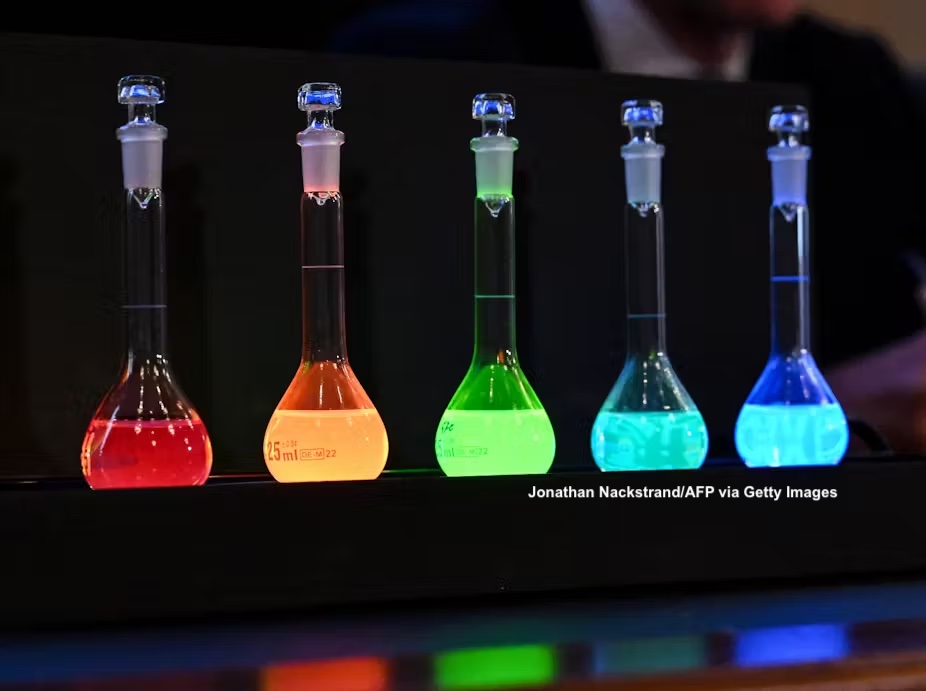
3 minute read
Charm City Science #7
Waste Not Want Not: Engineering Powerful Technologies from Kitchen Scraps
Quantum dots -microscopically small semiconductor particles- are revolutionizing the field of nanotechnology. Typically only a few nanometers (that’s millionths off a centimeter) in size, they offer exciting possibilities in everything from multicolored displays to medical imaging and solar cells. At such small scales, matter works in unexpected ways. Changes in electron behavior give nanomaterials unusual properties, including in the ways they interact with light. By altering their size, shape, or other features, quantum dots can be designed for all kinds of optical effects - making them very useful in applications like solar cells and photosensitive devices, bioimaging, and next-generation displays.
With all the promising possibilities quantum dots hold, there are some major concerns about sustainability. High-performance quantum dots are often made from toxic heavy metals, posing environmental and health risks. Enter carbon quantum dots (CQDs): a class of quantum dots that are made from carbon-rich materials, offering a non-toxic and environmentally friendly alternative. With CQDs, the same class of nanoparticles found in your expensive QLED TVs can be made from biological waste, including the kinds of scraps commonly found in a kitchen garbage.
In one striking example, Raji Atchudan and colleagues in India and Korea recently extracted these CQDs, from an unlikely source — kiwi fruit peels. Kiwi, well known for its rich vitamin C content and antioxidant properties, also contains high amounts of carbonbased compounds. Scientists have used this to create CQDs using a straightforward, lowcost process known as hydrothermal synthesis. In this method, kiwi fruit peels were crushed with water in a standard commercial mixer grinder. This was then mixed with a little ammonia and heated for 24h at a high temperature of 200 °C. Once this mixture cooled, the CQDs floated up in the solution to be filtered and collected.
These kiwi-derived CQDs have many potential uses - including in the field of photovoltaics, or light power. Solar cells rely on materials that efficiently absorb sunlight and convert it into electricity. Using quantum dots enables greater control over light absorption, potentially improving the efficiency of solar cells. By incorporating kiwi CQDs into photovoltaic devices, researchers aim to develop low-cost, high-performance solar panels that are both flexible and eco-friendly.
Kiwi-derived CQDs have promising applications in bioimaging as well. Due to their fluorescent properties, they can be used as bio-labels for tracking cellular interactions, offering a safer alternative to traditional fluorescent dyes. From harvesting solar energy to advancing cancer research, CQDs have the potential to make a remarkable impact across multiple industries. Clearly, big things indeed come in nano-sized packets.
As research into carbon quantum dots continues, the development of sustainable, waste-derived nanomaterials is gaining momentum. Fruit peels, often discarded as waste, are proving to be a valuable resource in the quest for cleaner, greener technologies. By harnessing the power of nanotechnology and sustainability, scientists are paving the way for a future where waste is not just reduced but repurposed into high-performance materials that can be used across various industries. The journey of quantum dots — from theoretical curiosities to real-world game changers — is unfolding, one fruit peel at a time.
Dhanvini Gudi is a PhD. Candidate in the NanoEnergy Lab, at the Johns Hopkins University department of Electrical and Computer Engineering


